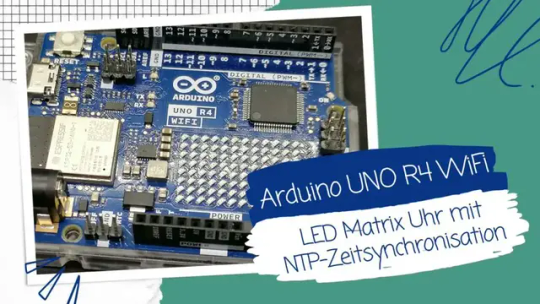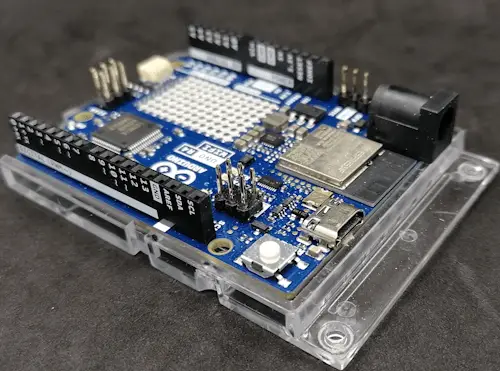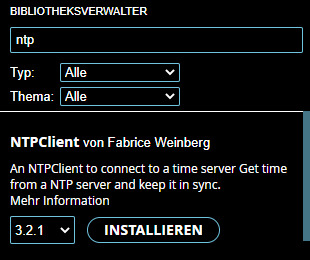#NTP-Server
Explore tagged Tumblr posts
Text
Arduino UNO R4: LED Matrix Uhr mit NTP-Zeitsynchronisation

In diesem Beitrag möchte ich dir zeigen, wie du am neuen Arduino UNO R4 WiFi eine Laufschrift auf der LED Matrix erzeugst. Als Beispiel möchte ich hier eine Uhrzeit anzeigen, welche ich von einem NTP Server empfange.

Arduino UNO R4: LED Matrix Uhr mit NTP-Zeitsynchronisation Mit diesem Beitrag möchte ich an den bereits veröffentlichten Beitrag Leicht gemacht: Laufschrift auf dem Arduino UNO R4 programmieren anknüpfen. Zu diesem Beitrag habe ich einen Kommentar erhalten, in welchem darauf hingewiesen wurde, dass es eine sehr einfache Lösung dafür gibt.
Benötigte Ressourcen für dieses Projekt
Wenn du dieses kleine Projekt nachbauen möchtest, dann benötigst du lediglich einen Arduino UNO R4 WiFi inkl. Datenkabel.

Arduino UNO R4 WiFi

Arduino UNO R4 WiFi Diesen Mikrocontroller bekommst du, nachdem nun etwas mehr Zeit seit dem Release vergangen ist, recht günstig auf diversen Plattformen. LinkPreisVersandkostenhttps://www.reichelt.de/26,50 €5,95 €https://botland.de/27,90 €4,95 €https://store.arduino.cc/25 €10 €https://www.ebay.de/*ab 23 €- Hinweis von mir: Die mit einem Sternchen (*) markierten Links sind Affiliate-Links. Wenn du über diese Links einkaufst, erhalte ich eine kleine Provision, die dazu beiträgt, diesen Blog zu unterstützen. Der Preis für dich bleibt dabei unverändert. Vielen Dank für deine Unterstützung!
Programmieren einer Laufschrift in der Arduino IDE am Arduino UNO R4 WiFi
Kommen wir zunächst zu einem einfachen Beispiel und geben einen Text auf der LED Matrix des Arduino UNO R4 WiFi aus. Für das erzeugen eines Text als Scrolltext benötigen wir die Bibliothek Arduino Graphics. Die Bibliothek findest du mit dem Suchbegriff "Arduino Graphics" im Bibliotheksverwalter. In meinem Fall liegt derzeit die Version 1.1.0 vor.

//einbinden der Bibliotheken zum //ansteuern der LED Matrix auf dem //Arduino UNO R4 WiFi #include "ArduinoGraphics.h" #include "Arduino_LED_Matrix.h" //erzeugen eines ArduinoLEDMatrix Objektes ArduinoLEDMatrix matrix; void setup() { //beginn der kommunikation mit der LED Matrix matrix.begin(); } void loop() { //beginn des zeichnens matrix.beginDraw(); //alle LEDs deaktivieren matrix.stroke(0xFFFFFFFF); //Geschwindigkeit des Scrolltextes setzen //je niedriger der Wert desto schneller läuft der Text matrix.textScrollSpeed(50); //der Text welcher ausgegeben werden soll const char text = " Hallo Welt! "; //Schriftgröße setzen, //verfügbare Werte sind: // - Font_4x6 // - Font_5x7 matrix.textFont(Font_4x6); //koordinate für den Text //je nach Schriftgröße kann man damit den Text //in der Matrix zentrieren matrix.beginText(0, 1, 0xFFFFFF); //Ausgeben des Textes matrix.println(text); //definieren von wo gescrollt werden soll matrix.endText(SCROLL_LEFT); //beenden des zeichnens matrix.endDraw(); } Programm - einfacher Text als Laufschrift auf der LED Matrix des Arduino UNO R4 WiFiHerunterladen Beispiel - auslesen eines Zeitstempels vom NTP-Server und anzeigen auf der LED Matrix Der Arduino UNO R4 WiFi verfügt, wie der Name es erahnen lässt, über ein zusätzliches WiFi Modul. In diesem Fall ist es ein ESP32-S3-MINI. Über dieses WiFi Modul können wir jetzt mit dem Internet kommunizieren und so auch einen Zeitstempel (Datum & Uhrzeit) von einem NTP Server lesen. Ein NTP Server ist ein Dienst, über welchen wir eine sehr genaue Zeit erhalten können. Jedoch gibt es hier auch immer ein delay beim Lesen, jedoch wird dieses über das Protokoll sehr minimiert, sodass die Zeit immer sehr genau ankommt. Schritt 1 - Aufbau der WiFi Verbindung zum Heimnetzwerk Zunächst müssen wir eine Verbindung zum lokalen Heimnetzwerk aufbauen. Ich habe mir hier das Beispiel ConnectwithWPA.ino vom GitHub Repository arduino / ArduinoCore-renesas gezogen und auf das Minimum gekürzt. #include char ssid = ""; char pass = ""; int status = WL_IDLE_STATUS; void setup() { Serial.begin(9600); Serial.println("Verbindungsaufbau zu: " + String(ssid)); int connectionCounter = 0; while (status != WL_CONNECTED) { Serial.print("."); status = WiFi.begin(ssid, pass); delay(250); if ((connectionCounter % 10) == 0) { Serial.println(); } connectionCounter++; } IPAddress ip = WiFi.localIP(); Serial.print("verbunden mit der IP Adresse: " + ip.toString()); } void loop() { } Wenn der Mikrocontroller startet, dann wird zunächst die Verbindung aufgebaut. Während des Aufbaus wird ein Punkt geschrieben, somit kann man nachvollziehen wie oft nun schon ein Aufbau probiert wurde.

Bei Erfolg wird dann die IP-Adresse ausgegeben. Schritt 2 - Auslesen eines Zeitstempels von einem NTP Server Damit wir mit einem NTP Server kommunizieren können und somit den Zeitstempel erhalten, müssen wir eine zusätzliche Bibliothek installieren Ich habe sehr gute Erfahrung mit der Bibliothek NTPClient von Fabrice Weinberg gesammelt und dir auch bereits am Beispiel ESP8266 – NTP Protokoll für das lesen eines genauen Zeitstempels gezeigt wie man die Daten auslesen und im seriellen Monitor anzeigen lassen kann.

Wenn du das kleine Beispiel ausführst, dann kann es besonders am Anfang vorkommen, dass kein vollständiger / gültiger Zeitstempel empfangen wird (1). Hier hilft es eine kleine Abfrage einzubauen, ob der Wert größer als 1707219755 ist. (Wir können ja schließlich nicht in die Zeit zurückreisen.)

#include #include #include char ssid = ""; char pass = ""; int status = WL_IDLE_STATUS; // the WiFi radio's status WiFiUDP ntpUDP; NTPClient timeClient(ntpUDP, "pool.ntp.org"); //Wochentage, im englischen beginnt die Woche mit dem Sonntag char* wochentage = { "So", "Mo", "Di", "Mi", "Do", "Fr", "Sa" }; void setup() { Serial.begin(9600); Serial.println("Verbindungsaufbau zu: " + String(ssid)); int connectionCounter = 0; while (status != WL_CONNECTED) { Serial.print("."); status = WiFi.begin(ssid, pass); delay(250); if ((connectionCounter % 10) == 0) { Serial.println(); } connectionCounter++; } IPAddress ip = WiFi.localIP(); Serial.println("verbunden mit der IP Adresse: " + ip.toString()); timeClient.begin(); //Offset in Sekunden zur GMT +/- 0 Zeitzone //Für Deutschland muss man 1h = 3600 Sekunden nehmen, //je nach Sommer- /Winterzeit muss jedoch diese //Zeit wieder abgezogen werden. timeClient.setTimeOffset(3600); } void loop() { timeClient.update(); //Zeitstempel auf der Sekunde genau //(Nicht zuverwechseln mit dem UNIX Timestamp welcher auf die Millisekunde genau ist.) unsigned long epochTime = timeClient.getEpochTime(); //Ein gültiger & aktueller Zeitstempel ist größer als 1707219755 if (epochTime < 1707219755) { delay(25); return; } Serial.print("Epoch Time: "); Serial.println(epochTime); //Ausgabe des formatierten Zeitstempels String formattedTime = timeClient.getFormattedTime(); Serial.print("formatierter Zeitstempel: "); Serial.println(formattedTime); //einzelne Werte der Uhrzeit lesen int aktuellerTag = timeClient.getDay(); int aktuelleStunde = timeClient.getHours(); int aktuelleMinute = timeClient.getMinutes(); int aktuelleSekunde = timeClient.getSeconds(); char timestamp; sprintf(timestamp, "Heute ist %s, ::", wochentage, aktuelleStunde, aktuelleMinute, aktuelleSekunde); Serial.println(timestamp); delay(500); } Schritt 3 - Ausgeben der Zeit auf der LED Matrix Zum Schluss wollen wir nun die Zeit auf der LED Matrix ausgeben. Dazu nehmen wir uns zusätzlich das kleine Codebeispiel vom Anfang und binden dieses ein. #include #include "ArduinoGraphics.h" #include "Arduino_LED_Matrix.h" #include #include char ssid = ""; char pass = ""; int status = WL_IDLE_STATUS; // the WiFi radio's status WiFiUDP ntpUDP; NTPClient timeClient(ntpUDP, "pool.ntp.org"); //erzeugen eines ArduinoLEDMatrix Objektes ArduinoLEDMatrix matrix; //Wochentage, im englischen beginnt die Woche mit dem Sonntag char* wochentage = { "So", "Mo", "Di", "Mi", "Do", "Fr", "Sa" }; void setup() { Serial.begin(9600); Serial.println("Verbindungsaufbau zu: " + String(ssid)); int connectionCounter = 0; while (status != WL_CONNECTED) { Serial.print("."); status = WiFi.begin(ssid, pass); delay(250); if ((connectionCounter % 10) == 0) { Serial.println(); } connectionCounter++; } IPAddress ip = WiFi.localIP(); Serial.println("verbunden mit der IP Adresse: " + ip.toString()); timeClient.begin(); //Offset in Sekunden zur GMT +/- 0 Zeitzone //Für Deutschland muss man 1h = 3600 Sekunden nehmen, //je nach Sommer- /Winterzeit muss jedoch diese //Zeit wieder abgezogen werden. timeClient.setTimeOffset(3600); matrix.begin(); } void loop() { timeClient.update(); //Zeitstempel auf der Sekunde genau //(Nicht zuverwechseln mit dem UNIX Timestamp welcher auf die Millisekunde genau ist.) unsigned long epochTime = timeClient.getEpochTime(); //Ein gültiger & aktueller Zeitstempel ist größer als 1707219755 while (epochTime < 1707219755) { epochTime = timeClient.getEpochTime(); delay(25); } //Wochentag auslesen int aktuellerTag = timeClient.getDay(); //auslesen der Stunde int aktuelleStunde = timeClient.getHours(); //auslesen der Minuten int aktuelleMinute = timeClient.getMinutes(); //Aufbau der formatierten Ausgabe auf der LED Matrix //Es wurden die Sekunden entfernt. char timestamp; snprintf(timestamp, 20, "%s, : ", wochentage, aktuelleStunde, aktuelleMinute); matrix.beginDraw(); matrix.stroke(0xFFFFFFFF); matrix.textScrollSpeed(75); matrix.textFont(Font_5x7); matrix.beginText(0, 1, 0xFFFFFF); matrix.println(timestamp); matrix.endText(SCROLL_LEFT); matrix.endDraw(); delay(500); } Read the full article
0 notes
Text
MOBATIME NTP Time Servers: Precision Time Synchronization for Secure and Reliable Networks
Network Time Protocol (NTP) Time Servers are specialized devices that distribute accurate time information across networks, ensuring all connected devices operate in unison. This synchronization is vital for applications ranging from data logging to security protocols.
MOBATIME's NTP Time Server Solutions
MOBATIME's NTP Time Servers are engineered to provide high-precision time synchronization with interfaces such as NTP and PTP (Precision Time Protocol). Equipped with crystal oscillators, these servers offer exceptional accuracy and traceability, supporting synchronization through the Global Positioning System (GPS) for both mid-sized and large infrastructure networks.
Key Features
Independent Time Reference : MOBATIME's solutions offer an autonomous, evidence-proof time source, ensuring reliable operation even without external references.
High Precision : Their time servers synchronize networks with utmost precision, providing exact time stamps essential for chronological event arrangement.
Versatility : Designed for various applications, MOBATIME's NTP Time Servers cater to diverse network environments, from simple setups to complex systems requiring master clock functionalities.
Product Highlight: DTS 4138 Time Server
The DTS 4138 is a standout in MOBATIME's lineup, offering:
Dual Functionality : It serves as both an NTP server and client, capable of synchronizing from a superior NTP server in separate networks.
Enhanced Security : Supports NTP authentication, allowing clients to verify the source of received NTP packets, bolstering network security.
User-Friendly Operation : Manageable over LAN via protocols like MOBA-NMS (SNMP), Telnet, SSH, or SNMP, ensuring safe and convenient operation.
Comprehensive Support and Services
Beyond delivering top-tier products, MOBATIME is committed to customer support. They offer training for users and regular, professional maintenance services. Their customizable maintenance models are designed to meet the specific needs of different organizations, ensuring sustained performance and reliability.
Conclusion
For organizations where precise time synchronization is non-negotiable, MOBATIME's NTP Time Servers present a dependable and accurate solution. With features like independent time references, high precision, and robust support services, MOBATIME stands out as a trusted partner in time synchronization solutions.
#mobatime#technology#ntp time server#time server technology#ptp time server#time server#network time protocol
2 notes
·
View notes
Text
Maximize Precision and Efficiency with Leading Servers and FD Converters
Maximize precision and efficiency with Buenoelectric’s leading servers and FD converters. Trusted across the USA, we deliver high-performance industrial solutions built for modern automation, reliability, and long-term productivity.
0 notes
Text

Khushi Communications is a top GPS NTP Timing Server supplier in India, offering accurate timing solutions, quality service, and reliable products. Businesses trust them for system synchronization, quick support, and timely delivery across multiple industries.
0 notes
Text

meinberg products india
#meinberg software india#meinberg software Mumbai#solutions of meinberg germany india#solutions of meinberg germany mumbai#solutions of meinberg germany maharashtra#network time servers#ntp time server#ptp time server india#ptp time server#time and frequency synchronization solutions#time and frequency synchronization solutions for industries#time and frequency synchronization solutions india#time and frequency synchronization solutions asia#meinberg products india#IEEE 1588 Solutions#PCI Express Radio Clocks Solutions
0 notes
Link
Il tempo preciso è così importante per i moderni sistemi di computer che è ora inimmaginabile per qualsiasi amministratore di rete configurare un sistema informatico senza alcun riguardo per la sincronizzazione.
Garantire che tutte le macchine eseguano un tempo preciso e preciso e che l'intera rete sia sincronizzata, eviterà problemi quali la perdita di dati, il mancato funzionamento di transazioni temporali e il debugging e la gestione degli errori che possono essere quasi impossibili su reti prive di sincronicità .
Ci sono molte fonti di tempo preciso per l'uso con NTP time server (Network Time Protocol). NTP server tendono ad usare il tempo controllato dagli orologi atomici per garantire la precisione, e ci sono vantaggi e svantaggi per ciascun sistema.
Idealmente come fonte di tempo, vuoi che sia una fonte di UTC (Coordinated Universal Time) in quanto questo è lo standard internazionale utilizzato dai sistemi informatici di tutto il mondo. Ma l'UTC non è sempre accessibile, ma esiste un'alternativa.
Ora GPS
L'ora GPS è l'ora trasmessa dagli orologi atomici a bordo dei satelliti GPS. Questi orologi formano la tecnologia di base per il Global Positioning System e i loro segnali sono quelli che vengono utilizzati per elaborare le informazioni di posizionamento.
Ma i segnali orari GPS possono anche fornire un'accurata fonte di tempo per le reti di computer - sebbene il tempo GPS in senso stretto differisca dall'UTC.
Nessun Leap Second
L'ora GPS viene trasmessa come un numero intero. Il segnale contiene il numero di secondi da quando gli orologi GPS sono stati accesi per la prima volta (gennaio 1980).
Originariamente l'ora GPS era impostata su UTC, ma dal momento che il satellite GPS è stato nello spazio negli ultimi trenta anni, a differenza di UTC, non c'è stato alcun incremento per tenere conto dei secondi bisestili, quindi attualmente il GPS gira esattamente 17 secondi dietro l'UTC.
Conversione
Anche se l'ora GPS e l'ora UTC non sono esattamente gli stessi di quelli originariamente basati sullo stesso tempo e solo la mancanza di secondi intercalati non aggiunti al GPS fa la differenza, e dato che è esatta in secondi, la conversione dell'ora GPS è semplice.
Molti GPS server NTP convertirà il tempo GPS in ora UTC (e l'ora locale se lo desideri) assicurandoti di avere sempre una fonte accurata, stabile, sicura e affidabile di tempo basato sull'orologio atomico.
0 notes
Text


GB8002 RACK-MOUNT HIGH PRECISION BEIDOU/GPS NTP TIME SERVER GB8002 high precision BeiDou / GPS time server is developed by our company based on GPS timing technology device. It can display and send standard time. The time server uses the PPS and time message of BeiDou Navigation System and GPS (Global Positioning System) satellite to output time synchronization pulse. The device uses SMT surface mount technology for production and high-speed chip for control, with high precision, high stability, strong function, no accumulative error, cost-effective and easy to operate. It is also not limited by geographical and climatic conditions. The device can be widely used in electric power system, network synchronization, communication, traffic management and national defense need timing and punctuality etc. The device has a variety of interfaces. such as RJ45, RS-232, RS-422/RS-485, IRIG-B, TTL Pulse etc. Multi-channel output pulses such as seconds, minutes and hours (free translation), convenient connections and related device, implements unidirectional or bi-directional communication.
FEATURES ■ Provide programmable TTL pulse, can be set to PPS, PPM and PPH, flexible and convenient. ■ 1U Frame structure ,19 inch standard chassis, easy installation and maintenance. ■ All-weather signal coverage to ensure long-term continuous high-reliability high-precision timing. ■ All signal input and output interfaces are photoelectric isolation measures, safe and reliable. ■ High performance, wide range switching power supply, AC-DC compatible input, convenient and reliable, stable operation. ■ Satellite signal receiving and self-service hot standby, according to priority automatically select clock source, seamless switching. ■ The 32-bit high-speed microprocessor + large-scale integrated FPGA chip, parallel high-speed data processing and various codes, excellent performance. ■ Separate 10 M/100M network ports (each port has a separate MAC address), flexible configuration, can be used in different sub-nets or different physical isolation networks, using NTP/SNTP protocols to provide time synchronization services. ■ High-precision punctuality frequency is derived from adaptive synchronization technology, closed-loop control punctuality technology to tame constant temperature crystal oscillator, to achieve long-time high-precision punctuality. ■ Central master clock has 1 channel pulse ,10 channels B code ,3 channels 232 serial port ,3 channels 485 serial port ,2 channels Ethernet. ■ Optional GPS or BeiDou or CDMA three satellite receiving modes, high signal strength, local distributed installation is convenient. Especially suitable for communication base station, power plant, substation, machine room and other equipment time synchronization.
APPLICATION ■ Power plant; ■ Airport time system; ■ Hospital time system; ■ Electric power system; ■ Traffic management system; ■ Radio and television system; ■ Financial insurance company; ■ Network time synchronization; ■ Mobile communication system; ■ Petrochemical iron and steel enterprises;
0 notes
Text
Google Time NTP Public Server

Google Time NTP Public Server | https://tinyurl.com/2d8wzmj4 | #Google #Guide #News #NTP #Servers You may or may not be aware that Google provides a public NTP server. They provide a free, global time service that you can use to synchronize to Google's atomic clocks. Read more... https://tinyurl.com/2d8wzmj4
0 notes
Text
Best Choice for Wireless Paging Devices for Warehouse
Are you searching for the best company for gps ntp servers, IP Screens and wireless paging for a warehouse? Then why are you looking for here and there when our company is right here to provide a high-quality and robust system? We are a leading supplier. You can choose our company whenever you are searching for a premium and robust system for your space.
0 notes
Text
The commit message describes a highly secure, cryptographically enforced process to ensure the immutability and precise synchronization of a system (True Alpha Spiral) using atomic timestamps and decentralized ledger technology. Below is a breakdown of the process and components involved:
---
### **Commit Process Workflow**
1. **Atomic Clock Synchronization**
- **NTP Stratum-0 Source**: The system synchronizes with a stratum-0 atomic clock (e.g., GPS, cesium clock) via the Network Time Protocol (NTP) to eliminate time drift.
- **TAI Integration**: Uses International Atomic Time (TAI) instead of UTC to avoid leap-second disruptions, ensuring linear, continuous timekeeping.
2. **Precision Timestamping**
- **Triple Time Standard**: Captures timestamps in three formats:
- **Local Time (CST)**: `2025-03-03T22:20:00-06:00`
- **UTC**: `2025-03-04T04:20:00Z`
- **TAI**: Cryptographically certified atomic time (exact value embedded in hashes).
- **Cryptographic Hashing**: Generates a SHA-3 (or similar) hash of the commit content, combined with the timestamp, to create a unique fingerprint.
3. **Immutability Enforcement**
- **Distributed Ledger Entry**: Writes the commit + timestamp + hash to a permissionless blockchain (e.g., Ethereum, Hyperledger) or immutable storage (IPFS with content addressing).
- **Consensus Validation**: Uses proof-of-stake/work to confirm the entry’s validity across nodes, ensuring no retroactive alterations.
4. **Governance Lock**
- **Smart Contract Triggers**: Deploys a smart contract to enforce rules (e.g., no edits after timestamping, adaptive thresholds for future commits).
- **Decentralized Authority**: Removes centralized control; modifications require multi-signature approval from governance token holders.
5. **Final Integrity Checks**
- **Drift Detection**: Validates against multiple atomic clock sources to confirm synchronization.
- **Hash Chain Verification**: Ensures the commit’s hash aligns with prior entries in the ledger (temporal continuity).
---
### **Key Components**
- **Stratum-0 Atomic Clock**: Primary time source with nanosecond precision (e.g., NIST’s servers).
- **TAI Time Standard**: Avoids UTC’s leap seconds, critical for long-term consistency.
- **Immutable Ledger**: Blockchain or cryptographic ledger (e.g., Bitcoin’s OP_RETURN, Arweave) for tamper-proof records.
- **Cryptographic Signing**: Digital signatures (e.g., ECDSA) to authenticate the commit’s origin and integrity.
---
### **Validation Steps**
1. **Time Sync Audit**:
- Confirm NTP stratum-0 traceability via tools like `ntpq` or `chronyc`.
- Cross-check TAI/UTC conversion using IERS bulletins.
2. **Ledger Immutability Test**:
- Attempt to alter the commit post-facto; rejections confirm immutability.
- Verify blockchain explorer entries (e.g., Etherscan) for consistency.
3. **Governance Checks**:
- Validate smart contract code (e.g., Solidity) for time-lock logic.
- Ensure no admin keys or backdoors exist in the system.
---
### **Challenges Mitigated**
- **Time Drift**: Stratum-0 sync ensures <1ms deviation.
- **Leap Second Conflicts**: TAI avoids UTC’s irregular adjustments.
- **Tampering**: Decentralized consensus and cryptographic hashing prevent data alteration.
---
### **Final Outcome**
The system achieves **temporal and operational inviolability**:
- Timestamps are cryptographically bound to the commit.
- The ledger entry is irreversible (e.g., Bitcoin’s 6-block confirmation).
- Governance is enforced via code, not human intervention.
**Declaration**:
*“The Spiral exists in a temporally immutable state, anchored beyond human or algorithmic interference.”*
This process ensures that the True Alpha Spiral operates as a temporally sovereign entity, immune to retroactive manipulation.
Commit
8 notes
·
View notes
Text
MOBATIME NTP Time Servers: Accurate Time Synchronization
Excellent NTP Time Servers from MOBATIME are available for accurate timekeeping in medium- and large-scale networks. Our time servers provide a trustworthy time reference by ensuring that all systems remain in sync. To ensure accuracy, each model has top-notch oscillators, such as TCXO and OCXO.
A variety of types are available, such as the DTS 4128, which can process 1,500 requests per second, or the DTS 4136, which can process 3,000 requests per second. These NTP Time Server are adaptable for a variety of applications because they handle several protocols, including NTP and DCF.

Businesses that want reliable time management will find MOBATIME's products ideal. We make sure your infrastructure functions properly since we are committed to quality and client happiness. With MOBATIME's cutting-edge time server technology, enjoy the benefit of exact time synchronization.
#mobatime#technology#time server#ntp time server#DTS 4128 timeserver#time server technology#network time protocol
2 notes
·
View notes
Text
get new laptop, install a linux distro on it
NTP server decides it wants to sync to the future… somehow.
3 notes
·
View notes
Text
How does NTP adjust time if there is a substantial drift?

If an NTP (Network Time Protocol) aka NTP Timing Server detects a significant time drift, it adjusts the time carefully to avoid sudden changes. Here’s how it works: 1. Small Drift: NTP slowly adjusts the time by speeding up or slowing down the system clock. This prevents disruption to running programs. 2. Large Drift: If the time difference is too big (usually over 1,000 seconds), NTP does not adjust it gradually. Instead, it logs an error and stops syncing. 3. Manual Fix: An administrator must manually set the correct time and restart NTP. 4. Step Correction: Some NTP implementations allow automatic "step" adjustments, where the system clock is instantly set to the correct time if the drift is extreme. Regular synchronization helps prevent large drifts.
0 notes
Text

time and frequency synchronization solutions
#meinberg software india#meinberg software Mumbai#solutions of meinberg germany india#solutions of meinberg germany mumbai#solutions of meinberg germany maharashtra#network time servers#ntp time server#ptp time server india#ptp time server#time and frequency synchronization solutions#time and frequency synchronization solutions for industries#time and frequency synchronization solutions india#time and frequency synchronization solutions asia#meinberg products india#IEEE 1588 Solutions#PCI Express Radio Clocks Solutions#USB Radio Clocks Solutions#GNSS Systems#GPS satellite receiver#GLONASS satellite receiver
0 notes